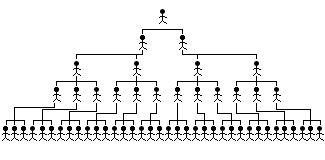Span of control and levels of hierarchy
The position of employees within a hierarchy indicates their status and authority. Those at the top are the most important and are paid a larger salary as they have more responsibility.

Level of hierarchy
Each layer of authority from the top to the bottom of the organisation is called a level of hierarchy or authority.
Each person in a level of hierarchy has the same equivalent status and authority. Tall organisation structures have many levels of hierarchy, whereas flatter structures have relatively few. As the number of levels of hierarchy increases, the organisation will face potentially negative consequences:
- Inflexibility - it will take a long time for information to move from the top management to those lower down the hierarchy.
- A 'them and us' mentality may be create as the people at the bottom of the hierarchy become increasingly remote from those at the top.

Span of Control
The span of control is the number of people directly accountable, and reporting, to one manager.
The span of control refers to the number of people that each manager is directly responsible for. A large span of control means that a manager has a large number of staff under their direct control, while a small span of control means that each manager looks after a small group of staff. This is an important topic as it is normally agreed that the wider the span of control the fewer levels of hierarchy the business needs. We can see this in figures 3 and 4.

Figure 3 A flat hierarchy - span of control

Figure 4 A tall hierarchy - span of control
A flat hierarchy, as in figure 3, will have a high span of control, whereas a tall hierarchy, as in figure 4, will have a much lower span of control.

Beware of making a statement that the CEO has the widest span because he or she is responsible for the entire organisation. The span of control refers to those reporting directly to a manager. In Figure 3, the head of the hierarchy only has a span of two people - it is the next tier down that has the very wide span
Early management writers argued that any span in excess of six would result in ineffective supervision, but later this was modified to a span of 4 to 8 for managerial functions and 8 to 15 at the lower levels of the organisation.
So why do some management theorists support wide spans of control?
- Delegation can be a more important part of how the organisation is managed.
- Those at the top of the hierarchy have less obvious control over subordinates.
- The distance between layers of management is less and those applying the decisions feel closer to those who originally made them.
- The need to be writing/communicating information is reduced as those lower down the hierarchy have the authority to carry out responsibilities.
- Costs can be reduced, as certain management functions are no longer needed. De-layering can take place.
- The subordinates may be very experienced and require less supervision
However, some theorists argue against this trend, pointing to the following as factors that need to be considered when considering a narrow span of control:
- There is less opportunity for delegation and the ultimate empowerment of employees.
- Those at the top can keep a tight control over employees.
- A distance can become apparent between those at the top and bottom of the organisation.
- A narrow span may encourage greater communication between layers of the management structure and clearer lines of communication.
- Training opportunities and personnel development can be more easily managed and attached to promotional opportunities
Whichever style is adopted, and probably most organisations develop combinations, the success of a span of control will rest largely on whether management has the ability to manage the situations that arise, motivate and direct employees to maximise their performance and whether the task lends itself to either a tight or relaxed supervision. For example, a small span of control is more likely to be effective in a production situation where close scrutiny of work is required to maintain quality.